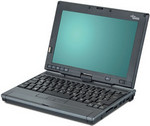Fujitsu-Siemens LifeBook P1620
Especificaciones de Portátil(es)

Price comparison
Promedio de 3 puntuaciones (de 4 análisis)
Análisis para el Fujitsu-Siemens LifeBook P1620
Origen: CNet
 EN→ES Archive.org version
EN→ES Archive.org versionThe Fujitsu LifeBook P1620 makes a few notable improvements on its predecessor, but a new breed of cheaper mini-laptops are on the horizon, making this ideal only for heavy tablet users, who may prefer a full-size tablet.
6.7 von 10, Mobilität mäßig, Leistung mangelhaft
Único Análisis, disponible online, Mediano, Fecha: 03/26/2008
Puntuación: Puntuación total: 67% rendimiento: 50% movilidad: 60%
Origen: Laptop Mag
 EN→ES Archive.org version
EN→ES Archive.org versionThe Fujitsu LifeBook P1620 packs more than enough functionality and usability to justify paying more than two grand. Consumers interested in a tiny tablet on a budget should probably gravitate toward the $999 LifeBook U810—provided you’re willing to use a smaller 5.6-inch display—but we highly recommend this more versatile and secure convertible for road warriors and field workers.
4 von 5, Mobilität sehr gut, Display gut, Leistung zufriedenstellend
Único Análisis, disponible online, Mediano, Fecha: 03/21/2008
Puntuación: Puntuación total: 80% rendimiento: 70% pantalla: 80% movilidad: 90%
Origen: Tom's Guide
 EN→ES Archive.org version
EN→ES Archive.org versionAlthough the Fujitsu Lifebook P1620 and Macbook Air aren’t marketed as direct competitors with each other, their light weight and convenient sizes certainly encourage comparison. In the final analysis, the Fujitsu Lifebook P1620 is, to our eyes, a more useful and utilitarian notebook than Apple’s Macbook Air. While the Fujitsu Lifebook P1620 is too thick to fit in a manila envelope, it’s lighter, smaller, arguably easier to pack and stow than the Macbook Air and offers a lot more ports and connectivity options. The Macbook Air, on the other hand, appears to be more aesthetically pleasing than the Lifebook, has a larger display and is available with a faster processor. But its lack of hardware adaptability, connectivity options and the ability to change the battery limits its usefulness in comparison to the Fujitsu Lifebook P1620.
Mobilität sehr gut
Único Análisis, disponible online, largo, Fecha: 02/28/2008
Puntuación: movilidad: 90%
Origen: Notebookjournal
 DE→ES Archive.org version
DE→ES Archive.org versionÚnico Análisis, disponible online, largo, Fecha: 04/24/2008
Puntuación: Puntuación total: 90% precio: 60% rendimiento: 30% pantalla: 70% movilidad: 70% procesamiento: 90% ergonomía: 70%
Comentario
Intel Graphics Media Accelerator (GMA) 950: Intel Graphics Media Accelerator 950 es un chip de video integrado (incorporado) en Mobile Intel 945GM chipset. Es una versión con frecuencia más rápida del GMA 900.
Muchos juegos son difícilmente ejecutables con estos adaptadores gráficos o se ejecutan de manera muy lenta.
>> Más información puede ser encontrada en nuestra comparación de tarjetas gráficas moviles y la lista de benchmarks.
Intel Core 2 Duo: Este es el sucesor Core Duo y el Core Solo con un pipeline más largo y con una velocidad entre 5-20% sin mayor consumo de energía. Adicional al diseño de Core Duo existe un cuarto decodificador, una unidad SSE ampliada y una unidad lógica aritmética (ALU) adicional.
Sus características son: 2 núcleos (cores), una amplificación de comando de 64-bit EM64T y 2 o 4 MB L2 Cache y 291 millones de transistores, que son acabados en 65nm. Mas allá de esto, todos los tipos soportan técnicas "Execute Disable Bit", SSSE3 (SSE4), Enhanced Speedstep, LaGrande y la mayoría de técnicas de virtualizacion (VT) Vanderpool.
El Core 2 Duo para laptops es idéntico a los procesadores Core 2 Duo para desktops, pero los procesadores para notebooks trabajan con tensiones más bajas (0.95 a 1188 Volt) y un Frontside bus clock (1066 contra 667 MHz). El rendimiento de laptops cuena con una frecuencia de 20-25% más baja que PCs Desktop debido a una frecuencia más baja de Frontside bus y los discos duros más lentos.
U7600:
>> Más información puede ser encontrada en nuestra comparación de procesadores móviles.





